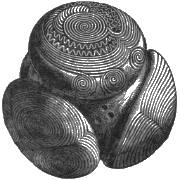Canmore Site 26751: ALMONDBANK - METHVEN - CIST(S) (PERIOD UNASSIGNED), PALISADED ENCLOSURE (PERIOD UNASSIGNED), FOOD VESSEL(S), NECKLACE(S) (JET), UNIDENTIFIED FLINT(S) (FLINT)
Description
| Site Name | ALMONDBANK |
|---|---|
| Other Name(s) | n/a |
| Site Number | NO02NE 40 |
| Broad Class | DRESS AND PERSONAL ACCESSORIES, MONUMENT (BY FORM), DEFENCE, RELIGIOUS RITUAL AND FUNERARY, CONTAINER, UNASSIGNED (OBJECT), DOMESTIC |
| Site Type(s) | CIST(S) (PERIOD UNASSIGNED), PALISADED ENCLOSURE (PERIOD UNASSIGNED), FOOD VESSEL(S), NECKLACE(S) (JET), UNIDENTIFIED FLINT(S) (FLINT) |
| NGR | NO 0582 2588 |
| NGR accuracy | NGR given to the nearest 10m |
| Local Authority | PERTH AND KINROSS |
| Parish | METHVEN |
| Record created | 1988-02-22 |
| Last updated | 2003-01-21 |
Archaeology Notes
NO02NE 40 0582 2588.
NO 054 260. Ten short cists were exposed near the top of a gravel bank during Forestry Commission operations in 1973. They were scattered over an area of 14.0m by 12.0m and lay within 2.0m of the surface.
Cist I: Long axis 80 E of N; partly destroyed and cover-stone cracked. Dimensions 0.85m by 0.55m. Contained an inhumation on a gravel floor. Cist II: Long axis 60 E of N; dimensions 0.88m by 0.54m. Contained a food vessel in NW corner with cremated bone; there were inhumed long bones at the other end of the cist. A radio-carbon date of 3556 +/- 80 (1606 BC) was obtained for the inhumation.
Cist III: Long axis 45 E of N; dimensions 1.04m by 0.42m to 0.64m. Contained an inhumation of a gravel floor; a fibrous substance under the thigh bone may have woven texture.
Cist IV: Destroyed. Hypothetical reconstruction 0.78m by 0.40m.
V: Low cairn 2.23m by 1.55m. No coverstone. Cist tightly packed with gravel and boulders; long axis oriented 55 E of N; dimensions 1.05m by 0.56m. At floor level, there was a scatter of comminuted charcoal for 0.66m from its E end.
Cist VI: Long axis oriented 55 E of N; dimensions 1.0m by 0.54m. Coverstone in pieces. Contained an unburnt skull and long bones.
Cist VII: Long axis oriented 80 E of N; dimensions 1.20m by 0.55m. Cist filled with gravel; large coverstone. Contained a skull and other bones of a crouched inhumation, accompanied by a jet necklace of 37 disc beads and 15 oblong beads and toggle, two unworked flint flakes, and a scraper of ? jasper. A radio-carbon date of 3517 +/- (1567 BC) was obtained from the inhumation.
Cist VIII, alongside cist VII: oriented 70 E of N. Gravel-filled, with a layer of clay instead of a cover-stone; dimension 0.91m by 0.64m. Contained a scattered, badly decayed inhumation.
Cist IX: Destroyed except for the end-stone. Oriented 123 E of N. Contained a jet necklace of 218 disc and 12 oblong beads and a long flint knife.
IX: An oval grave, oriented due E-W. Constructed of six stones, it measured 0.87m by 0.67m; no coverstone. Contained a fragmented food vessel and carbon.
An eleventh short cist was found in 1975. Its long axis lay 75 N of E. It has been filled with gravel in which was found an intact food vessel and a worked flint flake. From the teeth recovered, it was observed that five of the six burials were of young adults under the age of 30. The artifacts found in 1973 were donated to the National Museum of Antiquities of Scotland (NMAS) in 1973-4 by the Forestry Commission. (An anonymous note on Record Sheet indicates the find spot of these cists at NO 0582 2588.)
M E C Stewart 1973; 1975; Proc Soc Antiq Scot 1975
Identifiers and Links to Other Records
Would you like to help find more links?
| Identifier / External Link | Linked Record | Status | Comment |
|---|---|---|---|
| Canmore Site Number (legacy): NO02NE 40 | No linked record | ||
| NMS Primary Reference: 132320 | X.EQ 818 - Necklace | Definite | date, desc, location match |
| NMS Primary Reference: 132324 | X.EQ 822 - Necklace | Definite | all data matches |
This area is visible only to logged in users.
